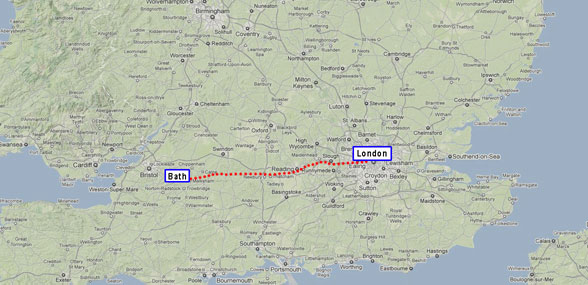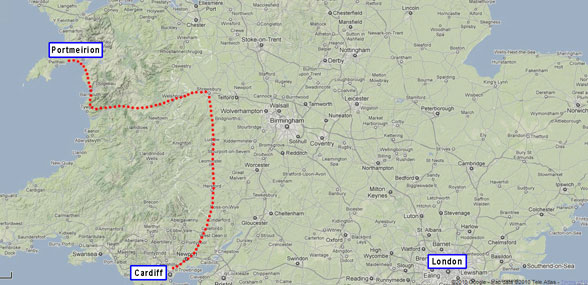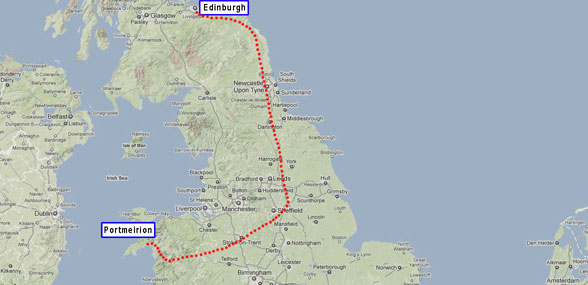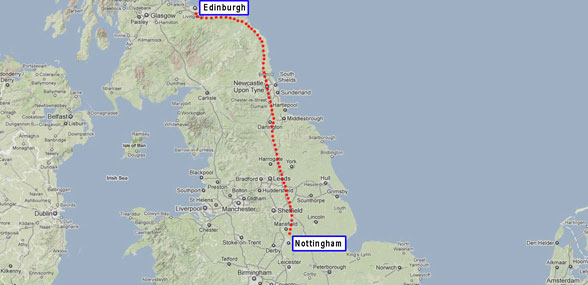UNITED KINGDOM VACATION, OCTOBER 2010


When we decided to go to England for vacation Steven asked what I wanted to see; a question which I am sure he now regrets. Of course I immediately thought about the mťlange of cultural touch-stones from the United Kingdom that we were inundated with while growing up. The great authors of course: Chaucer, Shakespeare, Dickens, Austin, Tolkien. Cultural icons like Stonehenge, Robin Hood, Big Ben, and Hadrianís Wall. And pop-culture references; ranging from Ab-Fab, The Prisoner, The Beatles, and Lulu to Princess Diana, Elton John, Mary Poppins and the Teletubbies. All this went through my mind as I tried to decide what I wanted to see in Merry Old England. I disgorged a list of everything I could think of and Steven made a valiant effort to fit it all into a two week vacation. What followed was our whirlwind tour of the most renowned tourist-traps in the whole United Kingdom.

We left Baltimore on a Thursday in early October. The weather was still quite warm, but we had packed plenty of sweaters (or as they call them, jumpers) and jackets for the trip. We arose at 4:30 in the morning and drove down to Virginia. Our flight was direct from Dulles to Heathrow, leaving around 9:30 AM and landing in England around 10:30 PM. Our friends had arranged for a private car to pick us up from the airport. The driver Jimmy was quite a chatty sort and tried to engage us in a conversation about British politics, a subject that we are woefully ignorant about especially after a long day spent crossing the Atlantic. We arrived at our friendís apartment in Marylebone , a swanky London neighborhood, after 11:00 and chatted as we polished off two bottles of wine before finally getting to bed.
We started our first day of sight-seeing by getting tickets on the double decker tour bus. Even though it was October and quite cool, the bus was still very popular and we had to scurry for seats on the upper deck. This was a good option because we could see a lot of the major attractions without having to stop and do anything. We did get off at Parliament and went to see the Prime Minister at 10 Downing Street. The street is gated off so we did not get to see the PM. Another thing we didnít get to see was Westminster Abbey; they were having some sort of a service that morning. We did see Big Ben, the Parliament building and the London Eye. Next we caught a ferry on the Thames to take us to the Tower of London, seeing St. Paulís Cathedral and the London Bridge along the way.
Now there is really only one reason to pay the admission price
for the Tower of London, and that is the Crown Jewels. Yes, in
the good old days they used to put the heads of state enemies on
stakes outside the tower; but those days are long gone.
Now the tower complex is just a bunch of Ďhistoricí but empty rooms
sitting on a prime piece of real estate. As soon as we got off the
ferry Steven took charge, getting the tickets and whipping us past
historic garrisons, historic chapels, historic toilets, yadda yadda
yadda until we finally reached the vault with the bling bling.
The Crown jewels are really an obscene reminder the British
colonialism and the way in which they plundered the wealth of half
the world. We actually saw one Indian family (turbans and dots)
staring longingly at the Star of India. During the high season the
line to see the jewels must be absolutely horrendous. There were
rooms and rooms of Ďeducational materialí with serpentine crowd
control belts directing us slowly to the main event. Since we were
there in October we were able to whiz right past all this, knocking
small school children out of the way as we went.
The crowns are
really quite spectacular. Of course they donít let you take pictures (because diamonds are sensitive to flash photography?) so these
are just images that I was able to pull off the web. My favorite
trinket was the jewel encrusted tiara worn by Queen Victoria.
After exiting the tower complex, we ate lunch at a lovely pub nearby.
It was here that Steve S. introduced us to the concept of mushy
peas as a side dish and learned of his loathing of minted mushy peas.
That afternoon we continued our bus tour of London, passing by many important sites none of which I can remember at the moment. We eventually ended up at Buckingham Palace. We couldnít go in, but saw the outside and so it gets checked off the list. Back on the bus to see more sights I donít really remember. We ended up at Hyde Park and the Marble Arch. The Arch is very pretty and used to be in front of the palace, but was moved and now sits in a traffic circle. Walking back to the apartment we stopped for a few drinks, then explored a food court where we learned that Marshmallow fluff is considered an American staple.
Going to see the Prime Meridian is the kind of geeky thing that I
like to do and Steven was a good sport to indulge me in this.
There is just something about standing at Longitude 0, or as they
say Ďthe centre of space and timeí. We took the Underground out
to Greenwich, which is located a few miles from the center of London.
Greenwich is a cute little town and the park around the Royal
Observatory is quite nice.
The Observatory was founded to help
British ships navigate the bourgeoning Empire. There used to be
competing Prime Meridians: this one, one through Belgium, and one
through Paris (the Rose Line of the Da Vinci Code). Imagine if you
were trying to make maps with Longitude and Latitude and you had to
pick among the competing meridians. In the late 1800s all the
countries of the world got together to pick one Prime Meridian and
they picked this one because it was the first (France objected of
course, damn French). The Meridian is marked by a steel band
running through the courtyard of the observatory. Not very scenic,
but we and a bunch of Asian tourists got our pictures of the line.
The morning of our visit was quite cloudy, but from the hill upon which the observatory sits we could see what used to be a royal palace with the river Thames in the distance. The palace is now a museum complex and we went there next. Truth be told, I didnít even know about the museums before we got there, but Steve S had been there before and recommended going in and Iím glad we did.
The Queenís House is an art gallery that contains the largest collection
of marine art in the world. It was originally collected to illustrate
the rise of British seapower from the Spanish Armada through the period
of colonial expansion in the 18th and 19th centuries. Wall sized oil
paintings of sweeping seascapes depicting masted ships crashing
through waves in epic battles. This is way cool stuff if you like
fine art or naval history.
The National Maritime Museum contains collections of artifacts from the British seagoing past. I was quite intrigued by the collection of sextants and compasses. There was also a exhibit of wind up toy boats that was enchanting. Outside the museum was a Harrier Jet simulator where you sit in a little chamber that rocks back and forth as a film runs in front of you. This was so cheesy that we had to do it.
We next took the subway back into London proper and went to the Borough Market. This is like a combination farmers market and flea market that is set up in the streets and is only open a few days a week. The place was incredibly crowded. This was Saturday afternoon and we had to squeeze through block after block of jam-packed Britons in order to get to a lunch spot that Steve S recommended. Lunch was sausage and beer and we had a fudge-packer brownie for dessert (need I say more).
Afterwards we walked along the Thames, passing by the restored Globe Theater (check it off the list), then went into the Tate Modern museum. Admission is free so the price was right, but we didnít spend much time there. In terms of sheer ridiculousness I would say the MoMA in NYC is the best, but there were some incredibly silly installations. We missed it, but a few days after our visit they covered the floor with millions of hand-crafted ceramic sunflower seeds and the papers were all abuzz about it.
Later we met Jim B at for a beer at a local pub, and then went to Abbey Road where the Beatles shot their photograph crossing the street for the Abbey Road album. Neither of us is a huge Beatles fan, but it seemed like an iconic London thing to do. Apparently many other people thought so a well because there was quite a little crowd gathered at the crosswalk outside the studio. Note that this is just a street; there isnít a sign, or marker, or even a gift shop to mark the location.
This is where we began to realize that the British donít know how to exploit their tourist attractions. This was October and there was a crowd gathered just to see a crosswalk. There should have been at least a street cart selling CDs and refrigerator magnets, but there was nothing. What a wasted business opportunity. The crowd was mostly of the backpacking, euro trash, youth hostel type; but we did meet a Boomer couple from Philadelphia who needed direction to the subway.
This seems a good place to mention pedestrians in England. People seem genuinely afraid of crossing the street and the cars do not stop or even slow down. Where people in Baltimore will saunter across the road; people in London scurry across like scared rabbits. What with wanting to look the wrong direction because the cars go the other direction and the fact that they will mow you over, street crossing was very stressful. At Abbey Road there were so many people trying to get pictures in the crosswalk, but the traffic was almost aggressive in not yielding.

Our next stop on the grand tour of England was the city of Bath, which
is about 40 miles West of London. This is one of those places we
learned about in school. Of course there was the Wife of Bath from
the Canterbury Tales. We also learned about the Roman ruins in Latin
class. For this reason Bath was somewhere I wanted to see even though
the city is not exactly the first place to spring to mind when you
think England.
A little bit about the history of Bath. This is the only natural
hot-spring in England. The original Britons had already built a
temple there by the time the Romans invaded and constructed a large
spa complex. A typical Roman bath was normally just a small room
because it took a lot of wood to heat that water. You would have only
seen a bath this size in the Emperorís palace in Rome where there were
bunches of slaves to keep the fire burning. Because this was a
hot-spring you could have a large heated pool without work. The
area became a center for social and business activities. Once
the Empire fell and the Romans withdrew from the island, the bath fell
into ruins during the Dark Ages. Silt build up buried the
complex and the ruins were lost. A small trickle of hot water continued
to bubble up from the site. Eventually a doctor decided that the water
had curative properties and the area once again became a site for
tourists to visit.
We arrived in Bath around 11:00 in the morning. We had shared the
train with many rugby fans heading for a game in Bath. The hotel
was near the train station and we were easily able to walk there
with our luggage in tow. Unfortunately our room was not ready, but
we were able to leave our luggage. The desk attendant just waved us
toward a closet, where we put our bags and could have rummaged
through any number of other peopleís things. For this reason
Steven elected to take his computer with us and ended up lugging
it about as we toured Bath. We were staying in a Best Western,
but it was more of a boutique hotel and lacked certain things you
might consider standard in the chain (like bell-hops).
We had booked a package through the Bath tourist office that included
a tour of the Roman baths, afternoon tea, and two hours at the
Thermae Bath Spa which is a modern pool complex fed by the hot
springs. After picking up our tickets, we had a coffee then went
to the Roman ruins. They have done a really good job of highlighting
the archeology of the site using multimedia presentations that
include cheesy video, models, and the body of a Roman solder who
had been buried there. Perhaps the most interesting thing is that
people used to write curses on lead plates and throw them into the
pool asking the gods to smite the people who have wronged them.
The pool itself is kind of slimy and overgrown with algae, but the
tour really showed how this place was once the height of luxury.
Afterwards we walked about the city, taking in the beautiful marble
homes that stretch for blocks and blocks from the city center. The
city really is gorgeous. By 2:00 we had wended our way back to the
hotel and were able to get our room, freshen up, and go out for tea.
The Pump Room is a Victorian gem, built to dispense the healing waters
of the spring to visitors seeking restoration. We had the choice of
lunch there or an afternoon champagne tea. The tea was lovely, with
live chamber music playing in the background. A glass of champagne,
fresh brewed tea, little sandwiches, and a selection of pastries.
We had brought our bathing suits, so went right to the spa after tea.
The Thermae Bath Spa has pools that are filled by the hot springs,
so in a way this is the modern equivalent of the Roman baths. There
is a large pool on the ground level and one on the rooftop. After
waiting in a rather long line to check in, we changed into our suits
and paddled about in the water. The water temperature was warm verging
on tepid. Imagine the scene: mid-October but the day had been warm.
An azure blue sky hangs overhead with just a few wispy clouds on the
horizon. After climbing several flights of stairs, you reach the
rooftop and a large rectangular pool filled with pasty white people
basking in the warm water. Close by, the spires of Bath cathedral
rise majestically above you catching the yellowish light of the
setting sun. In the distance the trees of the green clad hills are
just starting to be tinged by the colors of autumn. We spent a good
hour just lounging in the warm water and enjoying the sights.

Why go to Cardiff? Iím not sure I can give you a good answer
to that question. The main reason was that it is the capital of
Wales, but other than that we really didnít know anything about
the city. We checked into the hotel and asked at the front desk
what we should see in our one day. The castle and the harbor
were about the only things they could recommend. The city seemed
large, but fairly devoid of tourist attractions. Apparently Cardiff
has only been the capitol since the 1950s. The Welch people are
extremely nationalistic, but there isnít a whole lot that distinguishes
them. It was interesting that they have a BBC channel where they
only speak Welch. It sounds much like Old English, but the written
language has so many vowels in odd places that it is impossible to
even begin to guess how the words might be pronounced. Welch is
required in schools there, but really only people in isolated
villages still speak it as their primary language.
We went to the castle first because it was right across the street from
our hotel. Cardiff castle is just a shell. It was used during the
Norman conquests, but hasnít been an active fortress for about 700
years. It became the property of a rich family who built a mansion
next to it decorated in the style of the Gothic Revival. After
touring the castle grounds, we took a long walk down to the bay.
We had lunch on the water and looked around, but there wasnít much
to see. There was a bowling alley nearby in the Red Dragon mall so
we bowled a few frames and had a few beers. It was great fun, but
not exactly touristy. On the other hand, how many people do you
know who have gone bowling in Cardiff. That night we found a
traditional Welsh restaurant close to the hotel. I think I had
a meat pie of some type and local ale, but the meal wasnít
particularly memorable.

I went to graduate school in the Brazos Valley of Texas, which is mainly
flat, dry farmland with scrub trees, lots of cows, and very little else. I would
work very long days and get back to the apartment around 10:00 at night,
feeling totally strung-out after staring at the instrument monitor for hours on
end. The local PBS station would show at 11:00 PM reruns of the BBC show
called The Prisoner. This show was a revelation to me. For those of you
who donít know it, the plot is about this British agent who resigns from the
secret service, is drugged by people unknown, and wakes up in ĎThe Villageí
from which he can not escape. The episodes consist of the mysterious
establishment trying to get him to tell why he resigned, but you donít know
if it is our side or theirs that is holding him prisoner. Filmed in the late 60ís,
the show epitomizes the cold-war mentality and distrust of government that
was rampant at that time. To get a sense of why I love this show, click on this
YouTube clip. For a few short hours a week I was transported by this program
from the wasteland that is Texas into the extraordinary Village.
To look at it one would think that the Portmeirion was located somewhere on the Mediterranean, but it turns out that this is actually on the coast of Wales. An
eccentric English nobleman made it his lifeís work to build an Italian-style village
close to his families Welch estate. He started Portmeirion as a hotel in the 1920ís,
and gradually added buildings over the next 50 years. People found out that he was
creating this place and would donate architectural elements, like arches and columns,
which he would incorporate into the buildings.
My parents stayed here during an Elder Hostel a few years ago, so I knew that
Portmeirion was still open as a hotel. We booked a room through the web-site
and got an off season special rate. We left Cardiff early in the morning and traveled
the length of Wales, passing through numerous quaint towns with far too many
vowels in their names. The countryside is beautiful if sparsely populated. The train
stops approximately half a mile from the hotel. For being a rather popular tourist
attraction, there was absolutely nothing at the platform to indicate how to get to the
hotel and there was no chance to get a cab. We lugged our bags along roads without
sidewalks and eventually made it to the office. The woman behind the desk seemed
amazed that we hadnít called them for a ride. Once again the British prove that they
have no idea how to market an attraction.
Our room overlooked the Prisonerís villa from the show, which is now the Prisoner
gift shop. After dropping off our luggage we had lunch in an outdoor cafť then strolled
about the grounds. The day was gorgeous; who would have thought that mid-October
in Northern Wales could be so warm. Portmeirion was fantastic and I highly
recommend that you go there if you get a chance.




